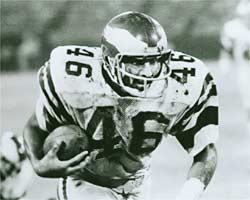Miracle at the Meadowlands
Fans of the New York Giants had much to lament as their team prepared to host the Philadelphia Eagles on November 19, 1978. After a promising start, the Giants had lost three consecutive road games to fall to 5-6. They had endured five consecutive losing seasons and hadn't been to the playoffs since 1963, the longest such droughts in the history of the ancient franchise.
Though it hardly seemed possible, things were about to get markedly worse.
Behind a solid defensive effort, the Giants managed to build a 17-12 lead and were in the process of running out the clock against Philadelphia. Less than a minute remained when the team huddled for the last time, the ball at its 29-yard line. The Eagles were out of time outs. Relieved fans shuffled toward the exits of Giants Stadium, expecting quarterback Joe Pisarcik to take the snap and dip to one knee.
But offensive coordinator Bob Gibson had other ideas. Hadn't Pisarcik taken a knee on the previous play? And hadn't Eagles middle linebacker Bill Bergey drilled center Jim Clack, knocking him into the quarterback and inciting a tussle? Gibson wasn't going to let that happen twice. He called a handoff to the fullback.
The Giants were horrified when the call came to the huddle. "Don't give me the football," fullback Larry Csonka insisted.
But Gibson had upbraided Pisarcik for changing a play against Washington a week earlier. The quarterback wasn't about to do it again.
Out on the left wing, Giants running back Doug Kotar looked across the line at second-year Eagles cornerback Herman Edwards. "We're practically shaking hands," says Edwards, now head coach of the New York Jets. "We had hardly huddled on defense."
 |
|
Herman Edwards
|
The Giants had spent too much time in the huddle. When they finally got to the line, Clack looked to the play clock and saw it winding down. Fearing a clock-stopping delay-of-game penalty, he snapped the ball. Unfortunately, Pisarcik was peeking back at Csonka, wondering if the famed fullback had accepted his assignment. The timing was shot. Pisarcik bobbled the snap, then hurriedly attempted to hand off to Csonka, planting the ball on the big man's right hip.
Kotar, who died of brain cancer in 1983, never saw the bounding fumble. But Edwards did. He sped into the backfield and fielded it cleanly. "That was the beautiful part," Edwards says. "It came to me on the first bounce."
As the remaining crowd gaped in stunned silence, Edwards dashed 26 yards into the end zone for the improbable winning touchdown with 20 seconds remaining. Eagles 19, Giants 17.
Among those who missed the play was Philadelphia head coach Dick Vermeil, who had turned away in frustration. "It dawned on him when he noticed people running by him," Edwards says. "He said, 'What are you doing?' And someone said, 'Herman ran it in for a touchdown!' He never saw it until he watched the tape."
The goofball play became an instant, tragicomic sensation. And the "Miracle of the Meadowlands," as sports fans soon called it, still resonates in Philadelphia and greater New York City.
"There are two versions of the story," Edwards says. "One is, 'I was at the game.' And that can't all be true, because there weren't enough people at the game for all the times I've heard it. The second is, they know where they were. They'll tell you, 'I was in a mall, standing in front of the TV,' or, 'I was in the parking lot. I turned the radio on and heard what happened.'"
Edwards's touchdown had ramifications both immediate and delayed. The Giants fired Gibson the next day. He never worked in football again. Not long after the game, outraged fans burned tickets in a bonfire outside the stadium. The Giants declined to renew the contract of head coach John McVay after the season. He joined the 49ers' front office in 1979 and became an integral part of that team's budding dynasty.
On the other side, Edwards is convinced the lucky bounce propelled the Eagles to new heights.
"We won the game at the end, and we went on to the playoffs," he explains. "The next thing, we're playing in the Super Bowl [two years later]. You see that in sports. One play gets you feeling like you have confidence. You're not worried about losing anymore; now you're thinking about how you can win."
The Miracle of the Meadowlands had another, longer-lasting effect on the NFL. Watch teams kneel down to kill the clock these days, and you'll almost always notice one player, usually a running back or defensive back, standing 5 to 10 yards behind the quarterback. As Pisarcik, Csonka, and their Giants cohorts learned the hard way, it never hurts to prepare for the worst.
(Editor's Note: This article on the Miracle of the Meadowlands game between the New York Giants and Philadelphia Eagles appeared on NFL.com last year.)